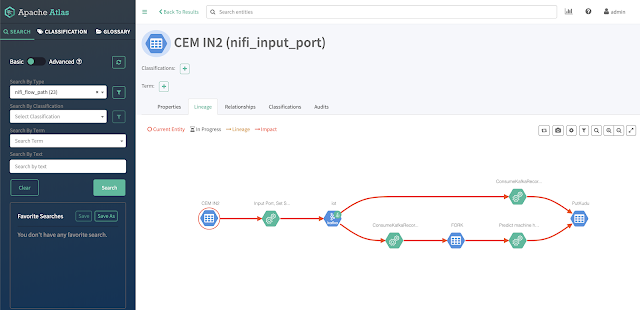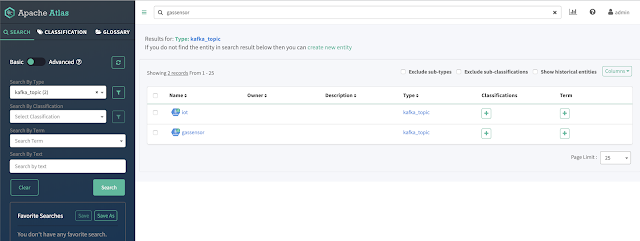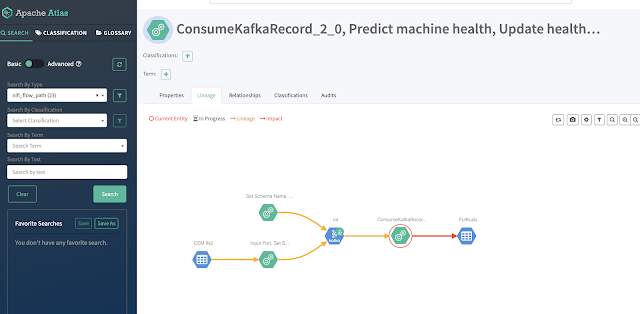EdgeAI: Jetson Nano with MiNiFi C++ Agent
Build and Utilizing The Apache NiFi - MiNiFi C++ Agent For Jetson Nano
(EdgeAI: Jetson Nano with MiNiFi C++ Agent)
source.hostname
jetsonnano
jetsonnano
source.ipv4
192.168.1.217
GetUSBCamera
FPS: .5
Bootstrap and Build
/opt/demo/nifi-minifi-cpp-source/build
bootstrap.sh
Options: Kafka, OpenCV, TensorFlow, USB Camera
Options: Kafka, OpenCV, TensorFlow, USB Camera
****************************************
Select MiNiFi C++ Features to toggle.
****************************************
A. Persistent Repositories .....Enabled
B. Lib Curl Features ...........Enabled
C. Lib Archive Features ........Enabled
D. Execute Script support ......Enabled
E. Expression Language support .Enabled
F. Kafka support ...............Enabled
G. PCAP support ................Disabled
H. USB Camera support ..........Enabled
I. GPS support .................Disabled
J. TensorFlow Support ..........Disabled
K. Bustache Support ............Disabled
L. MQTT Support ................Enabled
M. SQLite Support ..............Disabled
N. Python Support ..............Enabled
O. COAP Support ................Enabled
S. SFTP Support ................Enabled
V. AWS Support .................Disabled
T. OpenCV Support ..............Enabled
U. OPC-UA Support...............Enabled
****************************************
sudo apt-get install libcurl-dev libcurl4-openssl-dev -y
make
We can see when data arrives in NiFi from a MiNiFi Agent.
If CEM/Edge Flow Manager is a mystery to you, check out the live Swagger REST Documentation.
With MiNiFi C++ I can add a USB Camera.
Example Data
{"uuid": "nano_uuid_crr_20200218002610", "ipaddress": "192.168.1.217", "top1pct": 54.833984375, "top1": "cab, hack, taxi, taxicab", "cputemp": "45.5", "gputemp": "43.5", "gputempf": "110", "cputempf": "114", "runtime": "4", "host": "jetsonnano", "filename": "/opt/demo/images/image_esq_20200218002610.jpg", "imageinput": "/opt/demo/images/2020-02-17_1926.jpg", "host_name": "jetsonnano", "macaddress": "ec:08:6b:18:0d:7f", "end": "1581985574.6246474", "te": "4.158604383468628", "systemtime": "02/17/2020 19:26:14", "cpu": 51.8, "diskusage": "5479.7 MB", "memory": 71.4, "id": "20200218002610_8a12dd65-1038-41ac-b923-98fc907f5be0"}
Example Config.yml Section
name: AppendHostInfo
class: org.apache.nifi.minifi.processors.AppendHostInfo
max concurrent tasks: 1
scheduling strategy: TIMER_DRIVEN
scheduling period: 1000 ms
penalization period: 30000 ms
yield period: 1000 ms
run duration nanos: 0
auto-terminated relationships list: []
Properties:
Hostname Attribute: source.hostname
IP Attribute: source.ipv4
Network Interface Name: wlan0
Example Output
[2020-02-11 19:35:09.116] [org::apache::nifi::minifi::processors::ExecuteProcess] [info] Execute Command /opt/demo/rundemo.sh[2020-02-11 19:35:11.275] [org::apache::nifi::minifi::c2::C2Agent] [info] Checking 0 triggers[2020-02-11 19:35:13.742] [org::apache::nifi::minifi::c2::C2Agent] [info] Checking 0 triggers[2020-02-11 19:35:15.568] [org::apache::nifi::minifi::core::ProcessSession] [info] Transferring 899b5964-4d2f-11ea-8b9a-6e260e221e3d from ExecuteProcess - Python to relationship success[2020-02-11 19:35:15.568] [org::apache::nifi::minifi::processors::ExecuteProcess] [info] Execute Command Complete /opt/demo/rundemo.sh status 0 pid 31004[2020-02-11 19:35:15.569] [org::apache::nifi::minifi::core::ProcessSession] [info] Transferring 899b5964-4d2f-11ea-8b9a-6e260e221e3d from AppendHostInfo to relationship success[2020-02-11 19:35:15.649] [org::apache::nifi::minifi::sitetosite::SiteToSiteClient] [info] Site to Site transaction 4d0b460e-e4f6-4ca1-8c56-30d310a0712b sent flow 1flow records, with total size 3581[2020-02-11 19:35:15.785] [org::apache::nifi::minifi::sitetosite::HttpSiteToSiteClient] [info] Site to Site closed transaction 4d0b460e-e4f6-4ca1-8c56-30d310a0712b[2020-02-11 19:35:15.841] [org::apache::nifi::minifi::sitetosite::SiteToSiteClient] [info] Site2Site transaction 4d0b460e-e4f6-4ca1-8c56-30d310a0712b peer finished transaction[2020-02-11 19:35:15.841] [org::apache::nifi::minifi::io::HttpStream] [warning] Future status already cleared for http://ec2-35-171-154-174.compute-1.amazonaws.com:8080/nifi-api/data-transfer/input-ports/17979d5f-0170-1000-0000-000011f1cc00/transactions/4d0b460e-e4f6-4ca1-8c56-30d310a0712b/flow-files, continuing[2020-02-11 19:35:16.236] [org::apache::nifi::minifi::c2::C2Agent] [info] Checking 0 triggers[2020-02-11 19:35:16.263] [org::apache::nifi::minifi::core::ProcessSession] [info] Transferring 8a05413a-4d2f-11ea-8b9a-6e260e221e3d from TailFile to relationship success[2020-02-11 19:35:16.264] [org::apache::nifi::minifi::processors::TailFile] [info] TailFile nano.log for 616 bytes[2020-02-11 19:35:16.273] [org::apache::nifi::minifi::core::ProcessSession] [info] Transferring 8a05413a-4d2f-11ea-8b9a-6e260e221e3d from AppendHostInfo to relationship success[2020-02-11 19:35:16.274] [org::apache::nifi::minifi::core::ProcessSession] [info] Transferring 8a05413a-4d2f-11ea-8b9a-6e260e221e3d from PublishKafka to relationship success[2020-02-11 19:35:18.748] [org::apache::nifi::minifi::c2::C2Agent] [info] Checking 0 triggers[2020-02-11 19:35:21.260] [org::apache::nifi::minifi::c2::C2Agent] [info] Checking 0 triggers
Using Apache NiFi - MiNiFi C++ Agent Elsewhere
I am working on a Jetbot robot powered by NVidia Jetson Nano that will use the MiNiFi C++ agent.
References
Quick Tip: NiFi JSON Cleanup
From Vasilis Vagias:
evaluateJsonPath immediately after the InvokeHTTP and replace the flowfile content with the $.response then NiFi unescapes and removes the additional quotes auto magically.
This is helpful for occasions when CDSW returns JSON or other REST APIs which may double encode JSON files.
QuickTip: Ingesting Google Analytics API with Apache NiFi
QuickTip: Ingesting Google Analytics API with Apache NiFi
Design your query / test the API here:
https://ga-dev-tools.appspot.com/query-explorer/
Building this NiFi flow is trivial.

Add your URL with tokens from the Query Explorer console.

You will need to reference the JRE that NiFi is using and it's cacerts if you don't want to build your own trust store. The default password for JDK 8 is changeit. No really.
Here are our results in clean JSON
Here are some attributes NiFi shows.
Example JSON Results
{
"kind": "analytics#gaData",
"id": "https://www.googleapis.com/analytics/v3/data/ga?ids=ga:33&metrics=ga:users,ga:percentNewSessions,ga:sessions&start-date=30daysAgo&end-date=yesterday",
"query": {
"start-date": "30daysAgo",
"end-date": "yesterday",
"ids": "ga:33",
"metrics": [
"ga:users",
"ga:percentNewSessions",
"ga:sessions"
],
"start-index": 1,
"max-results": 1000
},
"itemsPerPage": 1000,
"totalResults": 0,
"selfLink": "https://www.googleapis.com/analytics/v3/data/ga?ids=ga:33&metrics=ga:users,ga:percentNewSessions,ga:sessions&start-date=30daysAgo&end-date=yesterday",
"profileInfo": {
"profileId": "333",
"accountId": "333",
"webPropertyId": "UA-333-3",
"internalWebPropertyId": "33",
"profileName": "monitorenergy.blogspot.com/",
"tableId": "ga:33"
},
"containsSampledData": false,
"columnHeaders": [
{
"name": "ga:users",
"columnType": "METRIC",
"dataType": "INTEGER"
},
{
"name": "ga:percentNewSessions",
"columnType": "METRIC",
"dataType": "PERCENT"
},
{
"name": "ga:sessions",
"columnType": "METRIC",
"dataType": "INTEGER"
}
],
"totalsForAllResults": {
"ga:users": "0",
"ga:percentNewSessions": "0.0",
"ga:sessions": "0"
}
}
You should have a lot more data depending on what you have Google Analytics pointing to. From here you can use QueryRecord or another record processor to automatically covert, query or route this data. You can infer a schema or build up a permanent one and store it in Cloudera Schema Registry. I recommend doing that if this is a frequent process.
Download a reference NiFi flow here:
https://github.com/tspannhw/flows
References:
https://developers.google.com/analytics/devguides/reporting/core/v4
https://developers.google.com/analytics
Analyzing Wood Burning Stoves with FLaNK Stack Part 2 - Analytics
Analyzing Wood Burning Stoves with FLaNK Stack Part 2 - Analytics - Part 2
Part 1: https://www.datainmotion.dev/2020/01/analyzing-wood-burning-stoves-with.htmlSee: https://shop.pimoroni.com/products/sgp30-air-quality-sensor-breakout
- Sensiron SGP30 TVOC and eCO2 sensor
- TVOC sensing from 0-60,000 ppb (parts per billion)
- CO2 sensing from 400 to 60,000 ppm (parts per million)
Running the fire I can see I am getting higher CO2 production than normal.
Since I stored my data in Kudu tables, it's easy to analyze with Impala and Hue.
select equivalentco2ppm, totalvocppb, systemtime
from gassensors
order by equivalentco2ppm desc
select avg( cast( equivalentco2ppm as double) ) CO2PPM
from gassensors
The average was 493.
Now that we have some time series data, I can start feeding this to some standard machine learning algorithms and have CML and a Data Scientist if me some analytics and help me determine where I a may want an alert.
When should you worry: https://www.co2meter.com/blogs/news/56788737-co2-sensor-range-compared https://www.co2meter.com/blogs/news/56788737-co2-sensor-range-compared
Up to 400 is considered normal.
400 to 1,000 is typical of occupied locations with air exchange.
Once you get over 1,000 you start getting drowsy and noticeable effects.
Over 2,000 you get headaches, this is a concern. Over 5,000 you should remove yourself from the situation.
select appx_median(cast(equivalentco2ppm as double)) median, min(cast(equivalentco2ppm as double)) min,
max(cast(equivalentco2ppm as double)) max, avg(cast(equivalentco2ppm as double)) avg,
stddev(cast(equivalentco2ppm as double)) standarddev,
stddev_pop(cast(equivalentco2ppm as double)) standardpop
from gassensors
Let's start setting alerts at various levels.
We can also look at the indoor air quality.
As a baseline for the sensor, in an empty ventilated room my numbers are:
{"uuid": "sgp30_uuid_glv_20200123132631", "ipaddress": "192.168.1.221", "runtime": "0", "host": "garden3", "host_name": "garden3", "macaddress": "dc:a6:32:32:98:20", "end": "1579785991.7173052", "te": "0.0261075496673584", "systemtime": "01/23/2020 08:26:31", "cpu": 53.5, "diskusage": "109138.7 MB", "memory": 46.5, "equivalentco2ppm": " 412", "totalvocppb": " 6", "id": "20200123132631_dec207f1-9234-4bee-ad38-a0256629c976"}
{"uuid": "sgp30_uuid_snt_20200123132633", "ipaddress": "192.168.1.221", "runtime": "0", "host": "garden3", "host_name": "garden3", "macaddress": "dc:a6:32:32:98:20", "end": "1579785993.7479923", "te": "0.02589273452758789", "systemtime": "01/23/2020 08:26:33", "cpu": 55.6, "diskusage": "109137.0 MB", "memory": 46.5, "equivalentco2ppm": " 403", "totalvocppb": " 5", "id": "20200123132633_3bd5fb39-d6b2-4f23-8904-0ada862ede2b"}
{"uuid": "sgp30_uuid_uha_20200123132635", "ipaddress": "192.168.1.221", "runtime": "0", "host": "garden3", "host_name": "garden3", "macaddress": "dc:a6:32:32:98:20", "end": "1579785995.7779448", "te": "0.025917768478393555", "systemtime": "01/23/2020 08:26:35", "cpu": 51.1, "diskusage": "109135.3 MB", "memory": 46.5, "equivalentco2ppm": " 406", "totalvocppb": " 3", "id": "20200123132635_0412f445-9b8c-43a8-b34a-a5466f914be7"}
{"uuid": "sgp30_uuid_wau_20200123132637", "ipaddress": "192.168.1.221", "runtime": "0", "host": "garden3", "host_name": "garden3", "macaddress": "dc:a6:32:32:98:20", "end": "1579785997.8079107", "te": "0.02591681480407715", "systemtime": "01/23/2020 08:26:37", "cpu": 58.7, "diskusage": "109133.5 MB", "memory": 47.1, "equivalentco2ppm": " 406", "totalvocppb": " 13", "id": "20200123132637_73f069d9-0beb-4d06-a638-2bd92e50ece7"}
{"uuid": "sgp30_uuid_lse_20200123132639", "ipaddress": "192.168.1.221", "runtime": "0", "host": "garden3", "host_name": "garden3", "macaddress": "dc:a6:32:32:98:20", "end": "1579785999.83777", "te": "0.025897502899169922", "systemtime": "01/23/2020 08:26:39", "cpu": 53.1, "diskusage": "109131.6 MB", "memory": 46.5, "equivalentco2ppm": " 410", "totalvocppb": " 1", "id": "20200123132639_1aa392fe-0eb7-4332-9631-83ac5838e153"}
Very low parts per billion between 1 and 13, with nothing changing in the static room seems like that's a 10 ppb margin of error, we can run some queries in Hue for better stats.
Let's look at some data over time for TVOC.
select appx_median(cast(totalvocppb as double)) median, min(cast(totalvocppb as double)) min,
max(cast(totalvocppb as double)) max, avg(cast(totalvocppb as double)) avg,
stddev(cast(totalvocppb as double)) standarddev,
stddev_pop(cast(totalvocppb as double)) standardpop
from gassensors
So what's a good TVOC? On average we are below the range of potential irritation of 120 - 1200 ppb. We do have some variance for sensor capabilities and lack of professional calibration. Median and Average numbers look good. The maximum is a bit disturbing but can be sensor error, warm up time or other data quality issues. We'll have to dive more into the numbers.
Next we can look at PM 2.5 values.
Need to crowd source some science here.
We had 3,500+ records of data over 120.
select count(*)
from gassensors
where cast(totalvocppb as double) > 120
I can see a number of records and the data climb as the fire burns and we add more cherry wood.
select systemtime, equivalentco2ppm, totalvocppb
from gassensors
where cast(totalvocppb as double) > 120
order by systemtime asc
I should also note that the time series data is coming in every 2 seconds.
select to_timestamp(systemtime, 'MM/dd/yyyy HH:mm:ss'), EXTRACT(to_timestamp(systemtime, 'MM/dd/yyyy HH:mm:ss'),
'MINUTE') as minute ,
cast(totalvocppb as double) as TVOC, cast(equivalentco2ppm as double) CO2PPM
from gassensors
order by systemtime desc
'MINUTE') as minute ,
cast(totalvocppb as double) as TVOC, cast(equivalentco2ppm as double) CO2PPM
from gassensors
order by systemtime desc
Resources
- https://joshefin.xyz/air-quality-with-raspberrypi-pms7003-and-java/
- https://en.wikipedia.org/wiki/Indoor_air_quality
- https://www.hackster.io/bastiaan-slee/chiiiiiirp-indoor-air-quality-measurement-and-alarm-260622
- http://wiki.seeedstudio.com/Grove-VOC_and_eCO2_Gas_Sensor-SGP30/
- https://learn.adafruit.com/adafruit-sgp30-gas-tvoc-eco2-mox-sensor?view=all
- https://www.weather.gov/arx/why_dewpoint_vs_humidity
- https://www.health.state.mn.us/communities/environment/air/toxins/voc.htm
- https://www.mdpi.com/2071-1050/11/22/6225/htm
- https://impala.apache.org/docs/build/html/topics/impala_datetime_functions.html#datetime_functions__from_timestamp
Analyzing Wood Burning Stoves with FLaNK Stack: MiNiFi, Flink, NiFi, Kafka, Kudu
Analyzing Wood Burning Stoves with FLaNK Stack: MiNiFi, Flink, NiFi, Kafka, Kudu (FLaNK Stack)
Winter has arrived, finally. The 50-70 F days are over, it dropped below 30 F in Princeton, so time to light up the wood burning stove and burn some season cherry wood (We get cherry wood from a local tree service that removes dead trees for people and then season the wood. Recycle!) . It's great for camp fires, smoking meats and for heating up our house. Also if you have no smelled cherry wood smoke it is amazing. I wanted to see if having a fire that raised my houses temperature from 67 F to 87 F would produce noticeable sensor readings. Fortunately, I have a thermal camera sensor (Pimoroni rocks! Add another thing to my list of thinks I love from Britain (Dr. Who, Jelly Babies, Pimoroni and my awesome boss Dan). I also have Raspberry Pi sensors for temperature, humidity, light and various gas sensors. Let's see what the numbers look like. The temperatures and images start greeen and yellow and as they heat up turn red, purple and then pure white. That's real hot. Fortunately the Raspberry Pis didn't overheat, had to open a window when we got close to 90. Yes, temperature regulation and maybe an automated wood feeder would be nice.
Inside the Stove
Cherry Wood burning nice in stove, notice Fire on Cloudera T-Shirt
Four USB PS3 Eye Cameras ($7!!!) attached to Raspberry Pi 3B+ and 4s.
A very organized professional assortment of Pis and sensors...
Some Sensor Readings:
{"bme280_tempf": "93.78", "uuid": "20200117195629_104c9f2a-b5a8-43d2-8386-57b7bd05f55a", "systemtime": "01/17/2020 14:56:29", "bme280_altitude": "-41.31", "memory": 92.1, "max30105_value": "84.00", "end": "1579290989.4628081", "imgnamep": "images/bog_image_p_20200117195629_104c9f2a-b5a8-43d2-8386-57b7bd05f55a.jpg", "max30105_temp": "34.56", "ipaddress": "192.168.1.251", "diskusage": "44726.6", "host": "garden2", "max30105timestamp": "20200117-145629-345697", "starttime": "01/17/2020 13:48:29", "bme280_altitude_feet": "-135.53", "max30105_delta": "0.00", "max30105_mean": "84.00", "max30105_detected": "False", "bme280_tempc": "34.32", "bme280_pressure": "1034.61", "cputemp": 59, "te": "4079.87322807312", "imgname": "images/bog_image_20200117195629_104c9f2a-b5a8-43d2-8386-57b7bd05f55a.jpg"}
[{"uuid":"sgp30_uuid_xyg_20200117185015","ipaddress":"192.168.1.221","runtime":"0","host":"garden3","host_name":"garden3","macaddress":"dc:a6:32:32:98:20","end":"1579287015.6653564","te":"0.025962352752685547","systemtime":"01/17/2020 13:50:15","cpu":55.0,"diskusage":"109290.8 MB","memory":29.7,"equivalentco2ppm":" 400","totalvocppb":" 37","id":"20200117185015_b8fbd9c1-fa30-4f70-b20d-e43a2c703b18"}]
{"uuid": "rpi4_uuid_kse_20200117222947", "ipaddress": "192.168.1.243", "host": "rp4", "host_name": "rp4", "macaddress": "dc:a6:32:03:a6:e9", "systemtime": "01/17/2020 17:29:47", "cpu": 50.8, "diskusage": "46208.0 MB", "memory": 18.2, "id": "20200117222947_e9299089-d56f-468b-8bac-897a2918307a", "temperature": "48.96355155197982", "pressure": "1035.4460084255888", "humidity": "0.0", "lux": "49.0753", "proximity": "0", "gas": "Oxidising: 30516.85 Ohms\nReducing: 194406.50 Ohms\nNH3: 104000.00 Ohms"}
{"host": "rp4", "cputemp": "72", "ipaddress": "192.168.1.243", "endtime": "1579293634.02", "runtime": "0.00", "systemtime": "01/17/2020 15:40:34", "starttime": "01/17/2020 15:40:34", "diskfree": "46322.7", "memory": "17.1", "uuid": "20200117204034_99f49e71-7444-4fd7-b82e-7e03720c4c39", "image_filename": "20200117204034_d9f811a3-8582-4b47-b4b4-cb6ec51cca04.jpg"}
The next step is to have NiFi load the data to Kudu, Hive, HBase or Phoenix tables for analysis with Cloudera Data Science Work Bench and some machine learning analytics in Python 3 on either Zeppelin or Jupyter notebooks feeding CDSW. Then I can host my final model on K8 within CDSW for a real edge to AI application and solve the issue of how much fire in my house is too much?
This article is part of the FLaNK Stack series, highlighting using the FL(ink) Apache NiFi Kafka Kudu stack for big data streaming development with IoT and AI applications.
Subscribe to:
Posts (Atom)

















































